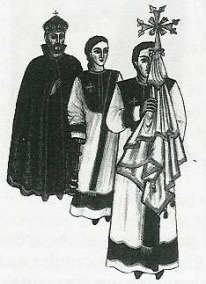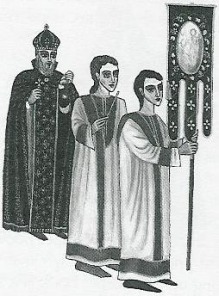The Divine Liturgy is the main worship service of the Armenian Church. But the Patarag, as we call it in Armenian, is much more than that. It provides the most intimate encounter we can have with God in this life. In the Divine Liturgy, Jesus Christ, the Son of God, comes to his people--to you and me--in two forms: first, by his Word, in the reading of the holy Gospel; and second, by his holy Body and Blood, in holy communion. These two actions--the reading of the Word of God, and the reception of holy communion--are the two pillars or building blocks of the Divine Liturgy in all ancient, apostolic churches.
Supported by these two pillars is a magnificent structure of words, music, symbols, and rituals. For those unfamiliar with it, the Divine Liturgy can seem like a bewildering array of disjointed movements and rituals, and arcane theological terminology. The complex interplay of the celebrant priest, the deacons, the other altar servers, the choir and the people might lead one to overlook the logic and purpose of the Divine Liturgy, and to miss its very real benefits.
Back in the tenth century, the great Armenian theologian Khosrov Antsevatsi eloquently described the importance of the Divine Liturgy when he wrote: "Since those who confess and show repentance receive atonement by means of the Holy Mystery [the Patarak], and are re-united to Christ in order to become for Him Body and members, we should be eager for the great medicine." The Divine Liturgy is the great medicine that provides true meaning and direction for our lives. It offers the peace and solace that only God can give--a free gift no less--in an age when so many people are searching, and spending millions of dollars in vain to find personal stability and security.
The Patarak really is a matter of life and death. This Web is intended as a explains how to do something to the Divine Liturgy of the Armenian Church. It is helpful information about points of interest along the way. It is desigined to accompany the new Divine Liturgy "Pew Book,"The Divine Liturgy of the Armenian Church: with Modern Armenian and English Translations, Transliteration, Musical Notation Introduction and Notes (New York: St. Vartan Press, 1999). Page numbers from the Pew Book have been placed in square brackets [] for easy cross-reference. While it will not answer all your questions, this Web will help you to discover the larger themes that unite the words, music and rituals of the Patarak. In this way, it is hoped, you will be drawn into deeper and more meaningful participation in the Divine Liturgy.
As we celebrate the 1700th anniversary of the Christian conversion of the Armenian people, the time is right to recommit ourselves to the Divine Liturgy, the "Holy Mystery" that for all these centuries has brought our people into blessed communion with the Lord our God.
Before the Patarak Begins: We prepare ourselves
We prepare ourselves for the Divine Liturgy both physically and spiritually. The custome of the Armenian Church is to fast from all food and drink from the time we wake up on sunday morning util we have received holy communion. Fasting helps us to focus our minds and hearts on the spiritual nourishment we will receive in holy communion. Exceptions are made, of course, for those who, for health reasons, must eat in the morning. They may have a light breakfast and still come forward for holy communion.
Spiritual preparation for the Patarak is by means of prayer. To participate fully in the Divine Liturgy, one should devote at least fifteen minutes of quiet time with God either on Saturday night, or on Sunday morning. This quiet time serves to help us focus on the great mystery of being with God. It can include reading of, and meditation on relevant passages from the Bible, or prayer and reflection.
As we shall see below, the Patarak is a procedure with a beginning, a middle, and an end. Therefore, it is very important to arrive in Church at least five minutes before the Divine Liturgy begins, and to remain attentive util the end. When we enter the Church, we make the sign of the Cross, take a place--preferably not in the rear pews--and standing, recite the Lord's Prayer. Then we may be seated in silence util the celebrant and servers enter the church.
Before the Patarak Begins: The Priest Prepares Himself
For the celebrant priest, the Divine Liturgy begins in silent prayer in the vestry. There, the priest and deacon alternately recite the verses of psalm 131, "Let your priests clothe themselves with righteousness; and let your saints exult with joy." The priest then prays to God, acknowledging his own sinfulness and the extraordinary privilege given to him by God to lead the people of God in the offering of the Divine Liturgy.
The various vestments worn by the priest are inspired by those worn by the jewish priests in the temple, as described in Exodus 28. Each article is accompanied by a brief prayer, which the priest offers as the deacon hands it to him to put on. As he puts on each successive garment, the priest prays that God will also clothe him with the grace and virtues to preside worthily at the Patarak: "Clothe me with a radiant garment and fortify me against the influence of the evil one, that i may be worthy to glorify your glorious name..."[3].
The Patarak Begins: Procession Into the Church and Up to the Altar

Led by the candle-bearers and altar servers, the celebrant enters the sanctuary from the vestry while the people sing, Khorkourt Khoreen, "Profound mystery." The "mystery" is Jesus Christ, the Son of God, who became a human being in order to fill us personally with his divine blessings, and with eternal life.
The Divine Liturgy begins not in the elevated altar space known as the bema (khoran), but among the people. Before the prayers at the altar, the priest again acknowledges his weakness and human frailty. As a visible sign that he relies on God to forgive his sins and make him worthy to worship God, the celebrant washes his hands, silently reciting Psalm 26: "I will wash my hands in innocence; and will go around your altar, O Lord." [4]. He then turns toward the people and confesses his sinfulness, asking them to pray that God forgive him. [5].

Only then, in the words of Psalm 100, does the assembly offer its first expression of praise, "Make a shout to the Lord, all lands; serve the Lord with gladness." [6].
Alternating the verses of Psalm 43, the priest and deacons go ip to the altar, where the celebrant prays for the first time, "...in this dwelling of holiness, this place of praise; in this habitation of angels, this place of the expiation of mankind; before these holy signs and the holy place that hold God up to us and are made resplendent..." [7]
Behind the Closed Curtain

The curtain is closed while the choir or a soloist sings a hymn appropriate to the feast or liturgical season.
At the altar, the priest offers the exquisite prayer of St. Gregory of Narek (t. 1003) to the Holy Spirit, a profound reflection in preparation for receiving holy communion: "...Prepare us to be honored dwellings, always ready to partake worthily of heavenly Lamb, to receive...this manna of life eternal..."[8].
When he has finished this prayer, the priest receives the Eucharistic bread and wine from the deacon. The priest prays that they be accpetable to God the Father, "who sent [the] Lord Jesus Christ, the heavenly bread, the food of the whole world, to be savior and redeemer and benefactor" [10].
While the deacon offers incense, the priest proclaims over the bread and wine the very same words that the angel Gabriel said to Mary when he announced that she would miraculously give birth to the Son of God [10]: "The Holy Spirit will come upon you and the power of the Most High will overshadow you" [Like 1:35].
While the priest and deacon attend to the preparation of the bread and wine, the orther altar servers are busy lighting the altar candles and forming the procession into the church. The main reason why the curtain is closed at this point in the Liturgy is so that the people will not be distracted from their prayer and reflection by the liturgical housekeeping taking place at the altar.
THE LITURGY OF THE WORD
The Procession and the Beginning of the Liturgy of the Word (Synaxis or Midday Office)

When the altar and the Eucharistic gifts have been prepared, the curtain opens and the deacons lead the priest in a procession around the altar and down into the nave. The priest offers incense to the main and side altars, the baptismal font, the sacred icons, and all the people. As the priest makes his way around the church, the faithful come up to him, kiss the hand cross and say, Hesshescheer yev zees arachee anmah kareenun Asdoodzo [ Remember me, too, before the immortal Lamb of God]. This is an acknowledgment that during the Divine Liturgy we encounter "the Lamb of God," Jesus Christ himself. The people ask that the priest pray for them in the presence of Jesus.
The procession marks the beginning of the Liturgy of the Word. Everything util this point has been a preparation for the Liturgy of the Word and the Eucharist, the two components of the Patarak. The Liturgy of the Word concerns the Word of God, Jesus Christ. He comes to his people in the public reading of the Bible, and especially when the deacon solemnly chants a passage from one of the four gospels (Matthew, Mark<, Luke, John). Every prayer, psalm, hymn and ritual during this part of the Divine Liturgy is related to Jesus Christ as the Word, the supreme expression of God. This idea is inspired by the Gospel acoording to John: "In the beginning was the Word and the Word was with God and the Word was God" [John 1:1].
Coming Soon!!!
Paragraph.
